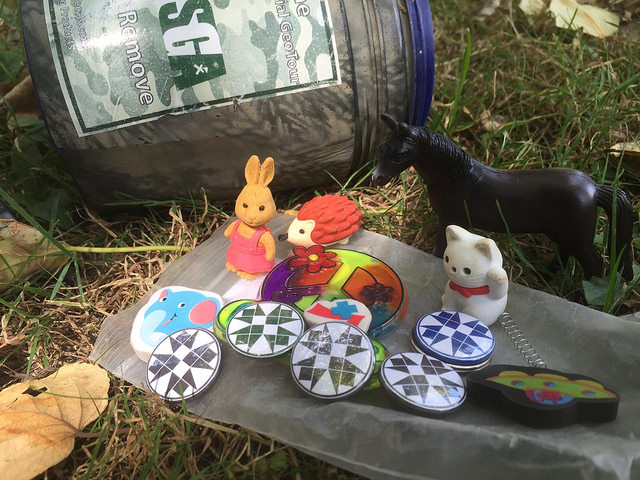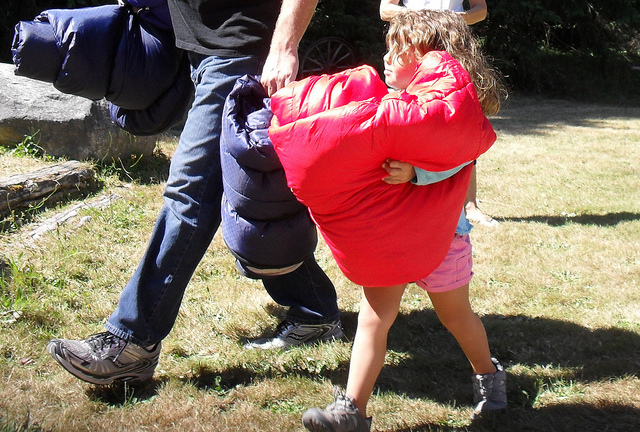Ten Tips for Hiking With Reluctant Kids
If the outdoors is your passion, but your little ones aren't quite as enthusiastic about hitting the trail, finding common ground can be a challenge. But there are many ways to encourage your kids to recreate outside, despite their cries of "It's boooooring" or their desires to stay inside. Here's what's worked best for some the parents in WTA's community.
And, if you need some trails to go implement these new ideas, take a look at our suggestions for best trails to visit with your reluctant hiker.
1. A hike doesn't have to be a "hike"
You might need to adjust your expectations of what a hike actually means. This is especially important early on, just to get kids comfortable in the outdoors.

When WTA's Southwest Regional Manager Ryan Ojerio was just beginning to hike with his daughter, he let her set the pace: "Letting Lola be self directed on trail often means we go a few hundred feet and she climbs a log or tree, we have some snacks, then go home."
"You're not going to get an aerobic workout hiking with little kids," says Linda Roe, whose children are now grown. Unless you've got them strapped to your back, trekking with little hikers is unlikely to deliver a workout. If that's a prime reason you hike, you may need to reducing or changing your expectations of a "hike".
Karyn Gaffney of Hike It! Baby suggests modifying your trips to favorite trails like one she suggested to the popular Rattlesnake Ledge: "You can just 'hike' around the lake and wander up the trail a way to munch the huckleberries. Pack a picnic and wade in the lake for an all-day thing!"
2. Make it about what they want
If you've been hiking for a long time it may take some adjusting to cater to your new little hiker's pace. But if you can prioritize their happiness, odds are you'll have a happier hiker, and a better chance of a return trip. If it's their first hike, ask if they'd like to bring a friend (plush animals make great hiking companions, too). Susan Elderkin, mother of two young hikers notes the power of having a friend along, and making sure you and your child have the same expectations for the trip.

Have a young hiker with a few trips under their belts? Ask them what they want to do. Give them three to four options for a destination. (Hint: Lakes or creeks are good starting points; places with safe, accessible water where you can wade or throw rocks, or nature trails with little critters and opportunities to get up close and personal with the world.)
Or, let them pick the activity for the trail. Ryan often asks Lola: "Do you want to hike, ride your mountain bike or go climbing?" Sometimes, she wants to do all three.
3. Change their perspective
If your kids run away when you say 'We're going on a hike!' try framing the trip in a different way. Make it about a goal they might be interested in, like: 'We're going into the forest to find the biggest tree ever!' or 'Let's go on a forest adventure!'

Letting kids dress up for their own adventure is another great way to change their perspective on the outing. Photos by Susan Gates.
WTA's magazine editor Jessi Loerch finds that calling a hike a picnic is a foolproof way of getting her daughter to be excited about heading out. "If she thinks we're going hiking, it's really hard to get her to excited. If it's a picnic, she's all in. It's the same trip, just framed a different way."
If your hiker has a favorite storybook or movie character like Toothless the Dragon, Captain America or a Disney princess, make them the hero of your hike.
4. Make time for activities
If you promise a picnic, story or particular adventure to get kids on trail, you've got to follow through when you get out there. Look for that huge tree or the best view ever. If your hike doesn't have a lot of noteworthy features, consider other on-trail activities to distract them from the monotony of putting one foot in front of the other.

A scavenger hunt is an excellent motivator. One of the items Ryan always puts in his scavenger hunts is a selfie on the summit, which encourages kids to finish the hike (and maybe find that best view ever).
Geocaching is also a wonderful distraction. There are many caches out there, and if the kids are slogging towards the end, you can bring up the Geocaching app on your phone. Usually there is one nearby and you can say, "Oh my gosh! there is a Geocache up ahead, lets go!!"
5. Be prepared (and then some)
Plenty of snacks and water are key for any successful hike with kids. On trail, it's important to make sure they're warm, dry and comfortable for the whole trip. Bringing extra gear can help with life lessons, too since on-trail experience can let kids learn the consequences of their decisions in a semi-controlled environment.

Ryan remembers, "Once on a rainy, cold fall hike, Lola splashed through a creek with her shoes on, then she wanted to take her pants off and play in the water and hike back. On the hike back, she got cold, so we put on her dry clothes, but she learned what happens if you get wet in the winter.
6. Plan around their sleep schedule
Well-rested kids make the happiest explorers, so be sure everyone's gotten plenty of sleep before heading out. Also consider their nap needs -- they might dictate your itinerary.

If they are afternoon nappers, your schedule should probably look something like this: Hike, Lunch, then Nap in the car on the way home. Be sure you don't hike so far before lunch that the hike back is a slow slog with cranky kids.
If your kids (or teenagers) need a little more sleep in the morning, plan to start later or let them snooze during the ride to the trailhead in their pajamas. If your kids are young enough, you can go whenever you want; you just might have to carry a sleepy tot.
7. Involve your kids in trip preparation
As they grow, you can give your kids more autonomy than just picking where you go or what you do. They can help ensure you have all the supplies you need for a safe trip.

For the first time, have them help you pack snacks. (Linda Roe says that sometimes unhealthy snacks are better motivators than healthy ones for particularly resistant hikers) or encourage them to choose their favorite hat or jacket.
When they head out camping, Ryan gives Lola her own tupperware box and a list with pictures (because she can't read yet) on it and she fills it up with her socks, pants, pajamas, and everything else she'll need for the weekend.
Get more tips for involving your older kids in hike planning.
8. Be willing to shoulder some extra weight
If you are really set on getting distance in, carry younger kids in a backpack or push them in a stroller. Even on short hikes, you may experience a "sit-down strike" from a little one who just won't go any further, and sometimes may need to carry them out.

On the other hand, shoulder rides sometimes offer a new perspective to the trail that your young one might like. Being higher up allows them to examine leaves and berries they may not normally be able to reach.
As your kids grow too old to carry, you can lighten their load (mentally and physically) by moving heavier items like water bottles into your own pack.
9. Rewards work, but use them wisely
Ice cream or earning an extra hour before bed are good for motivating positive behavior, but Ryan doesn't give them for accomplishments like reaching the end of a trail.
"So much in the outdoors can be affected by luck. Often if we fail to achieve a goal, it is because of my poor planning or time management rather than the kids' behavior. So rewards come when they control their own behavior, like when they follow directions well or stay positive on a long trip."

Instead, use short-term rewards and mini-milestones. Play games, run scavenger hunts or dole out special treats (yes, candy) along the way. Pack a thermos of hot cocoa or a special costume for the turnaround point.
10. Stay positive
Sometimes, nature conspires to throw every obstacle in your way -- it is raining, you didn't make it to the waterfall, your snacks spilled all over the ground and someone has a poopy diaper. In this case, it may be a difficult trip, but you will set the tone for the day, and it's up to you to turn a walk in the woods into a great adventure.

Your excitement and the promise of discovery is essential. Remember to stop and look closely at your surroundings. It may take a while, but eventually you'll hear a shout like, "Look at the size of that Banana slug, that is sooooo AWESOME!"

